Menus
- Daily trial for 15 days of both versions
- 649 cc, 68 hp – 47.5 hp in A2 – for 193 kilos
- Discovery
- In the saddle
- Contact
- In the city
- On the highway
- On departmental
- Braking
- Comfort
- Consumption
- Convenient
- Revisions
- The video of the comparo A2 full
- Conclusion
Daily trial for 15 days of both versions
649 cc, 68 hp – 47.5 hp in A2 – for 193 kilos
Who remembers the ER-6, the model unveiled in 2005 and since disappeared? In fact, the model continues its life well but under another more consistent surname in the Kawasaki range, with the Z for the roadster and the Ninja for the sports car.. The ER6-n thus became Z650 and the ER6f, Ninja 650. It was the great revolution of 2016 when the motorcycle changed to Euro4 which will now move to Euro5 … well next year. Because for the moment the Ninja 650 is only "Euro5 ready" as the manufacturer likes to say, to confirm that the bike remains in the catalog and will continue its life with just a few modifications to the injection and catalyst level. But while it was easy to guess that the ER6-f was a streamlined version of the roaster, what about the Ninja 650 compared to the Z650 and especially that the A2 version of the Ninja 650 is worth compared to? to the full version. Is the Ninja a motorcycle that you resell immediately after completing the A2-A bridge, or does it deserve to be kept with its potential by going full. Another way to put it, the A2 clamping transforms the motorcycle into a lung, deserving to turn to another model? Daily comparative test of the two A2 and full models.
 Comparo Kawasaki Ninja 650 A2 and full
Comparo Kawasaki Ninja 650 A2 and full
Discovery
When we discover the bike, we see that the transition from ER6-f to Ninja is not just a question of name. The Ninja 650 is now close to the look of all the other sports cars of the brand, with a marked DNA and much more rewarding than the Er6-f.
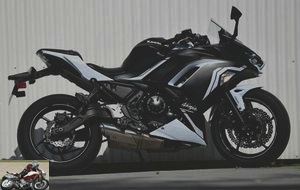 Black and white color of the 2020 vintage
Black and white color of the 2020 vintage
And that’s not just a question of looks, since underneath 2016 saw a new version of the liquid-cooled, dual ACT 649cc twin with now a slip clutch. The frame has also evolved, as has the swing arm, exhaust, wheels and brakes, with a big slimming cure losing 17 kilos to 193 kilos full made compared to the 210 kilos of the previous version. It is especially visible at the level of the old shock absorber present on the right side, which is replaced by a central model. Only the raised handlebars really differ from a supersport. We just regret the fact that the model lost 4 horsepower between the two versions, going from 72 to 68 horsepower with Euro4.
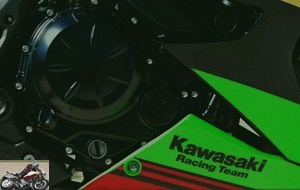 649 cc parallel twin, 4T, Euro4, Euro5 ready
649 cc parallel twin, 4T, Euro4, Euro5 ready
In 2019, the model is still evolving to look even closer to the different Ninja models from the 400 to the 1000. The saddle is modified to be more comfortable. The partly analog counter is replaced by a color TFT panel. The headlights and lights are now LED. And it benefits above all from the new Dunlop Sportmax Roadsport 2 tires (one-piece but high-end tire in one-piece, including at the rear, original equipment made in Japan, successor to the D214, intended for roadsters and sports cars and available in the catalog). On the other hand, it loses its adjustable bubble. And inevitably, with these improvements, the price unfortunately climbs by 300 euros, going to 7,799 euros (whether it is the A2 or full version) and 7,949 euros for the SE version (in green).
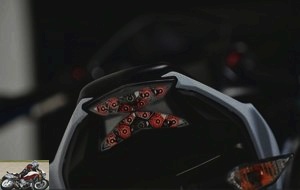 LED rear light
LED rear light
In any case, with this Ninja 650, we are in the big leagues. And for all those who want to start with a real sports car, this is the solution, at least in terms of the look. And then, in black and white, it finally contrasts with the usual green even if the 2020 vintage benefits from this specific decoration..
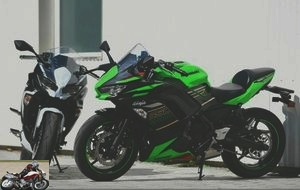 Kawasaki Ninja 650 A2 vs full
Kawasaki Ninja 650 A2 vs full
In the saddle
Finally a motorbike accessible to all! 1.70 m and I manage to put both feet on the ground, which is extremely rare for me who am short on legs. Sandrine, who is barely more than 1.60m, also gets there. It’s not as low as a custom, but it’s a bike for everyone, at least for accessibility. Thanks to the reasonable saddle at 790 mm and especially the narrow tank. And with a fairing, you really do not want to ask the slightest during an overhang. This is really the first positive point of the beginner’s bike.
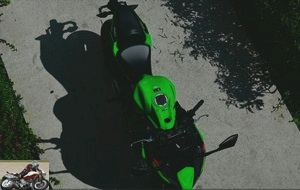 Saddle accessible to 790 mm
Saddle accessible to 790 mm
The bust tilts gently to catch the levers, adjustable, but the position remains natural. It is not the upright position of a roadster, but neither the broken wrists that we see on a sports car. This is the second positive point of a beginner’s bike, especially for a "sporty" one..
And then the knees can grip the tank well and we immediately find ourselves well and at home on the model. Better, even the big ones of 1.90m will manage to find themselves there well, without resembling a frog, with legs a little bent but not too much and which find their place in the notch of the tank..
 An easy-to-access machine for beginners
An easy-to-access machine for beginners
The old dashboard was readable but old school! TFT is fashionable and it is the case for this 2019-2020 vintage. Long live modernity! But we must admit that it is super readable, including under the sun. Speedometer, tachometer, shiflight, gear engaged, clock as well as all the information from the on-board computer are there with average and instantaneous consumption, autonomy, "eco" indicator (which shows you when you drive smoothly like a song ).
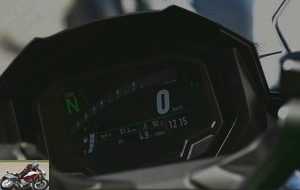 Dashboard with TFT panel
Dashboard with TFT panel
And modernity requires, you can even connect with your smartphone in Bluetooth now via the Rideology application. This gives you information on the fuel gauge, the meter, the maintenance schedule, etc. but also with the Riding Log on the route and the engine speed. And we have the joy of being able to have a notification on the dashboard when receiving a call, text or email.
We just regret having to still be able to scroll through the information only by looking for pushbuttons on the meter instead of having a button on the stalk switch.
Contact
The twin snorts in an almost serious way. First, second, the Ninja 650 sets off whether in A2 or full version. And you are right at home, not only because of the driving position, but the ease of handling. We find the ease of driving that made the success of the ER6, both for the beginner and the more experienced pilot..
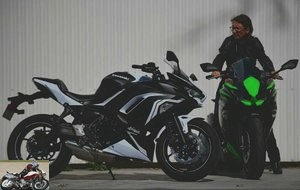 A well-made A2 clamp for a pleasant everyday motorcycle
A well-made A2 clamp for a pleasant everyday motorcycle
In the city
The flexibility of the twin is surprising, when we remember the first ER6 which hit easily. This is also the case of the Versys 650 which hits hard in town on high gear. But the Ninja 650 is much easier at this level with dynamic flights, which make it easy to find yourself at 50 km / h in first (which goes up to 60) or second, without really noticing a difference. noticeable between the two models on a daily basis. Yes, the full house has more gnac, but in town and on a daily basis, we do not try to whip the cavalry and the two models do the job very well..
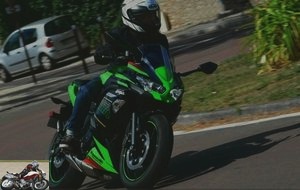 Maneuverability and ease of driving in the city
Maneuverability and ease of driving in the city
This is explained by the clamping, only electronic, with almost identical torque between the two models (58 against 64 Nm), the A2 version even having its peak torque much earlier, at 4,700 rpm against 6,700 rpm for the full house. Suddenly the approval in town is identical between the two models, even the A2 is a little more pleasant. Certainly, on the exercise of the last report in town and at 2,000 rpm at 40 km / h, the Ninja 650 knocks, but if we stay between 2nd and 3rd gear, we slip easily into traffic, with an interfile just as easy. Only the mirrors far enough on the fairing do not offer an ideal vision and especially a different vision depending on the position you take on the bike, a little more bent or on the contrary more straight. Everything is helped by a gearbox that is forgotten with reports that happen very easily. Even the injection at low revs makes it possible to wind quietly without jerking. U-turns are also easily done, with excellent machine balance that does not give the impression of falling on slow-speed maneuvers..
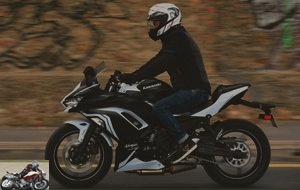 A flexible motor
A flexible motor
The A2 version differs here from the full version by its much easier braking and really much smoother and progressive than the full version. All of this makes the Ninja one of the easiest sports cars in town..
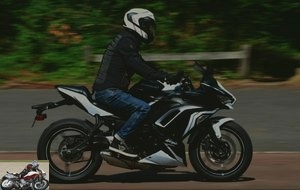 47.5 hp at 8,000 rpm in A2
47.5 hp at 8,000 rpm in A2
On the highway
The Ninja 650 literally takes off as soon as it enters the highway … in its full version. This is where we note the time needed for the A2 version to reach 130 km / h and then gain kilometers / hour. The motorcycle stalls at 4,000 rpm at 90 km / h, then 5,000 rpm at 110 and 6,000 rpm at 130, i.e. 4,000 rpm from the red zone, gaining 10 km / h every 1,000 rpm / min. At this rate, the bubble is enough, not to protect the helmet but to deflect the air and we could happily maintain a much higher cruising speed … since the Ninja can – on the German motorway – reach 200 km / h . And a notable point, the bubble is no longer adjustable in 2020 and we wonder why while the previous model allowed it.
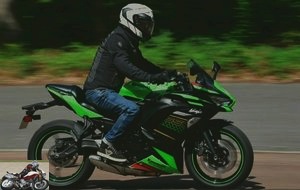 68 hp at 8,000 rpm
68 hp at 8,000 rpm
At this speed, the instantaneous consumption stabilizes at 4 liters / per hundred, guaranteeing the possibility of driving far and for a long time..
On departmental
We suspect that with ease of driving in the city that the Ninja 650 will reveal its full potential on small roads and it immediately proves it with the addition of a precise front axle. It is thus easily placed on the angle, maintains its trajectory without any parasitic movement, except when the asphalt degrades and the speed increases. Only then does the whole begin to live (move) but always in a very healthy way. The Dunlops do a great job here, with excellent grip.
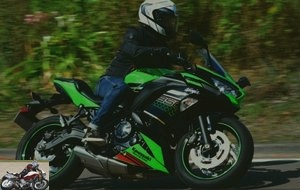 Precise front axle
Precise front axle
And whatever the pace, the mill is attractive, especially in its full version, but the A2 version is not bland. A good pilot will even be able to show it on the A2 version against a young full house, so much the machine is carried away. The A2 version is even more linear than the full version, but at least we are never surprised. Because if there is something that characterizes the two models, it is a steady rise in speed, without ever kicking the butt at a certain speed and this up to the maximum power at 8,000 rpm (2,000 rpm under the red zone). We can just as easily go to illuminate the shiftlight on the dashboard while knowing that the sensations are before and do not require going to tease the switch. We do not hesitate to go down instead of gears to oscillate between 3rd and 4th, knowing that the 3rd is already going happily at 110 km / h (and as we know, the departmental roads are limited to much less than that).
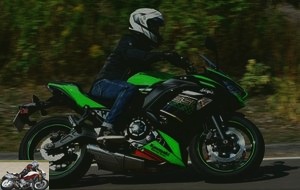 64 Nm at 6,700 rpm
64 Nm at 6,700 rpm
Braking
Whatever the model, we have double semi-floating 300 mm petal discs offering excellent braking feeling. But it’s crazy how you can get two different settings depending on the two theoretically identical models. During our test, the A2 model offers a dosable, soft, progressive braking, with a little intrusive ABS while the full model offers a braking with more bite, much more powerful, making the bike dive under braking and with an incoming ABS. easily in solo action. We are therefore tempted to say that beginners will love the A2 version and pilots will appreciate the efficiency of the full version. But Kawasaki confirms that there is no mechanical difference however between the two versions. In any case, everything is largely at the level of the machine.
 Double discs in semi-floating 300 mm petals. Double piston calipers
Double discs in semi-floating 300 mm petals. Double piston calipers
Comfort
This was the strong point of the ER6-f. But we told you that the Ninja is not just a rebadgage and indeed a sports car. The double-stage saddle without grab handle confirms this for the passenger who will therefore find himself in the traditional position of a sportswoman and will therefore have to hang on to stay in the saddle (in full version). But the passenger seat remains less exclusive than on certain sports cars with the possibility of remaining fairly straight. The A2 version being smoother when accelerating and braking, it remains more livable if necessary. In any case, this places it among the easiest in the sports category for the passenger. The driver is better off in all cases, with a shock absorber worthy of a Kawa roadster and far from the usual wooden plank of green sports cars. In addition, there is no vibration and you can therefore ride for a long time on board without wanting to stop.
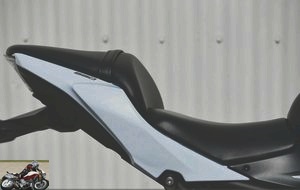 Rather flexible suspensions for everyday comfort
Rather flexible suspensions for everyday comfort
Consumption
It is good that we do not want to stop, because the Ninja has a bird’s appetite, almost identical whether we are in A2 or full version, with about 5 liters per hundred in solo and in smooth ride, even capable of dropping below 5 liters in really cool mode. Instantaneous consumption even indicates 3.5 liters / 100 at 90 km / h in the last gear. You necessarily climb when you start to open the handle and even more if you add the duo, especially in A2 which encourages you to open more to gain in sensations. We thus increased the consumption to 6.4 liters for the A2 model and below 6 liters for the full model. In the end, the range can go up to 300 km, but we can also make the reserve indicator light up at 175 km, the six sticks of the gauge then lowered. !
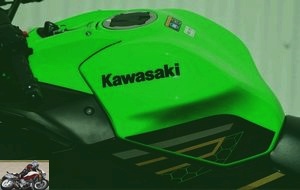 15 liter tank for nearly 300 km of autonomy
15 liter tank for nearly 300 km of autonomy
Convenient
There is a little space under the saddle, enough to put two small U-type locks or the compulsory vest.
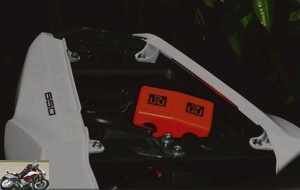 A little space under the saddle to accommodate two small locks
A little space under the saddle to accommodate two small locks
Revisions
Revisions take place every 12,000 km (or every year) with oil change, spark plug replacement, checks.
The video of the comparo A2 full
Conclusion
The Ninja 650 entered the sport class but without sacrificing too much to the versatility of the ER6-f. The A2 version is a daily treat, far from the wounds of sportswomen in general and largely sufficient in sensation for a beginner. And when it goes full (68 hp), it gives this surplus of power which gives the extra pep to go to work on small roads, without being afraid either, enough to accompany at least a beginner who would keep his Ninja A2 for simply switch it to full, especially since the jailbreak package costs only 90 euros. In the end, we have a motorcycle that is easy to access but not stingy with sensations, pleasant on a daily basis (yes, I repeat myself but when we talk about sports it’s important), healthy, homogeneous and reassuring. It thus resolves a little squaring the circle in the category, even going so far as to have its Tourer pack (850 euros) with suitcases to go far with.
Strong points
- Ease of handling
- Engine flexibility
- Very urban for a sportswoman
Weak points
- Duo
- Linear motor
The technical sheet of the Ninja 650
Test conditions
- Itinerary: everyday city + varied small roads + interurban highways with a little town
- Motorcycle mileage: 300 km
Related articles
-
Roadster with Sugomi sauce or decarenated sports car A2 licenses have the choice between large bridles, sometimes very badly bridled, and smaller ones,…
-
Kawasaki 1400 GTR motorcycle test
THE GT There always comes a time when every motorcyclist wonders about the positioning of his passion. And the current offer, with its various…
-
2009 Kawasaki ER-6f ABS motorcycle test
Test of the faired version of the Kawasaki ER6 ABS twin-cylinder The Kawasaki ER6f is the streamlined version of Akashi’s ER6 twin-cylinder roadster…
-
Kawasaki Z 750 motorcycle test
Cure of youth After a big success and more than 62,000 models sold, the Kawasaki Z750 evolves only 3 years later its output: engine, chassis and design….
-
Kawasaki Versys 650 motorcycle test
Twin-cylinder 649 cc, 69 hp, 210 kilos, A2 version, euro5 ready Daily test 2006, the year of the successive revivals of Kawasaki on segments where we…
-
2007 Kawasaki Z1000 motorcycle test
Five-day test of the 2007 vintage roadster The Kawasaki Z1000 released in 2003 was well received but mixed: a look of hell but an engine considered like…
-
Kawasaki Z H2 Supercharged motorcycle test
200 hp, 14 mkg at 8,500 rpm, 239 kg all full, 17,099 € Put some salt ! Fifteen days of driving with the Kawasaki Z H2? I say it bluntly, it takes less to…
-
Kawasaki Versys 1000 S Grand tourer motorcycle test
Daily test for fifteen days 1,043 cm3, 120 hp at 9,000 rpm, 102 Nm at 7,500 rpm, 257 kg, 15,099 euros (17,099 euros Grand Tourer version) This bike, to…
-
Kawasaki Ninja ZX-10R KRT motorcycle test
An integer character 4 cylinders in line, 998 cm3, 203 hp, 114.9 Nm, 206 kg all full facts, 18,099 euros. Nice surprise for me to find the Kawasaki…
-
2009 Kawasaki ER-6n motorcycle test
3-day twin-cylinder roadster test The Kawasaki ER6n is Akashi’s twin-cylinder roadster initially introduced in 2005, which has achieved unprecedented…
Beautiful CR, and (like what I do not just criticize) much more pleasant to read than sometimes (is it the same author ?? )
)
At this level of performance in quality and look, they could – at no additional cost – offer a 250 in the same frame..
I think that by offering a 125 and 250 version at the same price, that would boost sales by more than 20%. The competitors have only to behave!
I think that the notion of sportswoman (ity, although well done …), is here, despite everything quite subjective, even if it is a Kawa.
This is perhaps where it comes closest, philosophically speaking, to the late previous Z650.
I love the expression ‘pocket katoche’ and ‘little plague’.
an atypical 125, if there is one, and indeed where it goes wrong, it is the vibrations.
Nice, the report
Nice, the javascript report: editor_tools_handle_smiley_select (" ")
")
How classsss she looks, I’m waiting for the 250 with undisguised impatience
tom4